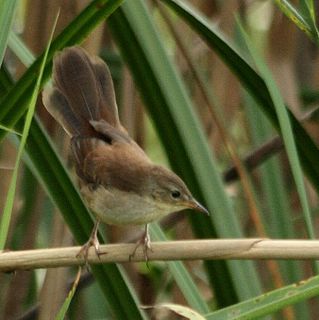
Bradypterus is a genus of small insectivorous songbirds ("warblers") in the newly recognized grass warbler family (Locustellidae). They were formerly placed in the Sylviidae, which at that time was a wastebin taxon for the warbler-like Sylvioidea. The range of this genus extends through the warm regions from Africa around the Indian Ocean and far into Asia.
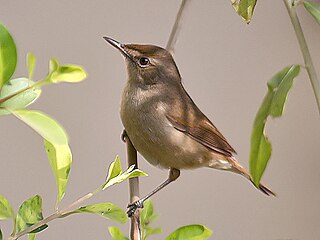
Blyth's reed warbler is an Old World warbler in the genus Acrocephalus. It breeds in the Palearctic and easternmost Europe. It is migratory, wintering in Bangladesh, India and Sri Lanka. It is one of the most common winter warblers in those countries. It is a rare vagrant to western Europe.

The golden-fronted leafbird is a species of leafbird. It is found from the Indian subcontinent and south-western China, to south-east Asia and Sumatra.
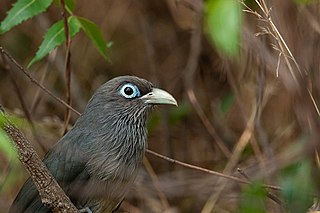
The blue-faced malkoha or small green-billed malkoha, is a non-parasitic cuckoo found in the scrub and deciduous forests of peninsular India and Sri Lanka. It has a waxy, dark, blue-grey plumage on its upperparts and has a long tail with graduated white-tipped feathers. The throat and chin are dark with spiny pale feathers that are branched. The lower belly is a dull creamy to rufous colour. The bill is apple green, and a naked patch of blue skin surrounds the eye. The sexes are alike. The blue-faced malkoha is a bird of open forests and scrub jungle.
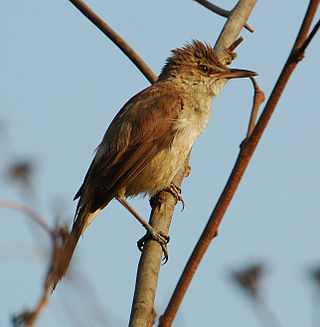
The clamorous reed warbler is an Old World warbler in the genus Acrocephalus. It breeds from Egypt eastwards through Pakistan, Afghanistan and northernmost India to south China and southeast Asia. A. s. meridionalis is an endemic race in Sri Lanka.

The plain prinia, also known as the plain wren-warbler or white-browed wren-warbler, is a small cisticolid warbler found in southeast Asia. It is a resident breeder from Pakistan and India to south China and southeast Asia. It was formerly included in the tawny-flanked prinia, resident in Africa south of the Sahara. The two are now usually considered to be separate species.

The jungle prinia is a small passerine bird, a warbler in the family Cisticolidae.

The grey-breasted prinia or Franklin's prinia is a wren-warbler belonging to the family of small passerine birds found mainly in warmer southern regions of the Old World. This prinia is a resident breeder in the Indian subcontinent, Sri Lanka and southeast Asia. Like other prinias, it often holds the tail upright but it is easily told by a smoky grey band across the breast which contrasts with a white throat. The beak is all black while the legs are pink. The tail is graduated as in other prinias and the grey feathers are tipped in white. In the breeding plumage the upperparts are grey while non-breeding birds are pale above with rufous wings and a weak supercilium. It is found in scrub, forest clearings and other open but well vegetated habitats. It can be confused with the rufescent prinia.

The watercock is a waterbird in the rail and crake family, Rallidae that is widely distributed across Southeast Asia. It is the only member of the genus Gallicrex.
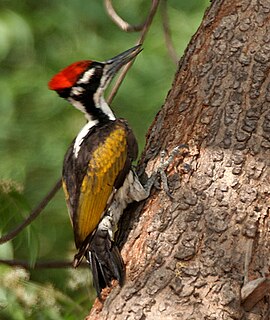
The white-naped woodpecker is woodpecker which is a widespread but a scarce breeder in the Indian Subcontinent. It is associated with open forest and scrub with some trees. It nests in a tree hole, laying one or two white eggs.

The yellow-eared bulbul is a species of songbird in the bulbul family of passerine birds. It is an endemic resident breeder in the highlands of Sri Lanka. The common name is also used as an alternate name for the yellow-throated bulbul.

The orange-billed babbler also known as Ceylon rufous babbler or Sri Lankan rufous babbler is a member of the family Leiothrichidae.

The ashy-headed laughingthrush is a member of the family Leiothrichidae. The laughingthrushes are a large family of Old World passerine birds characterised by soft fluffy plumage. These are birds of tropical areas, with the greatest variety in southeast Asia.

The tawny-bellied babbler also known in older Indian works as the rufous-bellied babbler is a small babbler that forages in small groups in low scrub forests. Like other members of the large Old World babbler family they are passerine birds characterised by soft fluffy plumage. There are three subspecies within the Indian Subcontinent. The nominate hyperythra found in northern and eastern India is uniformly brown underneath while albogularis of the western Indian peninsula is white throated. The population in Sri Lanka, phillipsi, is also white throated but is paler underneath and has a larger bill.

The dark-fronted babbler is an Old World babbler found in the Western Ghats of India and the forests of Sri Lanka. They are small chestnut brown birds with a dark black cap, a whitish underside and pale yellow iris. They forage in flocks in the undergrowth of forests constantly making calls and uttering alarm calls when disturbed.

Legge's flowerpecker or the white-throated flowerpecker, is a small passerine bird. It is an endemic resident breeder in Sri Lanka. It is named after the Australian ornithologist William Vincent Legge.

The streak-throated swallow or the Indian cliff swallow is a passerine bird, which includes a large number of other species including many swallows. It is native of South Asia where it is a breeder, year-round resident or winter visitor in the countries of Afghanistan, India, Nepal and Pakistan. It occurs as a vagrant in the Maldives, Sri Lanka, and the Middle East.

The Taiwan bush warbler is a species of Old World warbler in the family Locustellidae. It is found only in Taiwan. Its natural habitat is undergrowth and grassland 1,200–3,000 m (3,900–9,800 ft) in elevation. It was first recorded in 1917 and named as a distinct species in 2000. The International Union for Conservation of Nature (IUCN) has assessed it as a least-concern species.

Locustellidae is a newly recognized family of small insectivorous songbirds ("warblers"), formerly placed in the Old World warbler "wastebin" family. It contains the grass warblers, grassbirds, and the Bradypterus "bush warblers". These birds occur mainly in Eurasia, Africa, and the Australian region. The family name is sometimes given as Megaluridae, but Locustellidae has priority.
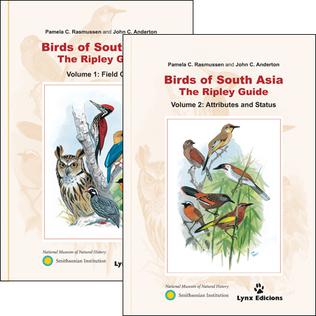
Birds of South Asia: The Ripley Guide by Pamela C. Rasmussen and John C. Anderton is a two-volume ornithological handbook, covering the birds of South Asia, published in 2005 by the Smithsonian Institution and Lynx Edicions. The geographical scope of the book covers India, Bangladesh, Pakistan, Sri Lanka, Nepal, Bhutan, Maldives, the Chagos Archipelago and Afghanistan. In total, 1508 species are covered. Two notable aspects of Birds of South Asia are its distribution evidence-base — the book's authors based their distributional information almost completely on museum specimens — and its taxonomic approach, involving a large number of species-level splits.





















